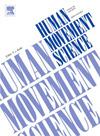Effect of immersive virtual reality on overground gait stability in children with cerebral palsy: A prospective case-control study
IF 1.9
3区 心理学
Q4 NEUROSCIENCES
引用次数: 0
Abstract
Purpose
To evaluate the effect of walking in a virtual world, particularly on a virtual plank at varying heights, on gait stability in children with cerebral palsy (CP) and typical development (TD).
Method
Twenty-two participants with CP (13 males; 11 years 2 months) and twenty-four with TD (10 males; 11 years 11 months) were included. After undergoing clinical gait analysis, participants were immersed in VR via a head-mounted display and walked on a virtual plank at varying heights. Linear mixed-effect models were fitted for: margin of stability (MoS), whole-body angular momentum (WBAM), single limb support % (SLS), variability of step length (SLV), stride width (SWV), and kinematics (GaitSD). Fixed effects were group (CP vs. TD), condition (walking in the real world vs. virtual world) and virtual height.
Results
GaitSD and SWV were positively correlated with VR, and lateral MoS was negatively correlated. Lateral MoS and coronal WBAM were positively correlated with CP and VR, while anterior MoS and sagittal WBAM were negatively correlated. Lateral MoS was positively correlated with height in CP, while anterior MoS, sagittal WBAM, SLS, SLV and SWV were negatively correlated.
Conclusions
Virtual heights induced gait instability, which was more pronounced in CP than TD. WBAM, SLV, and SLS were the most appropriate biomarkers for defining gait instability.

沉浸式虚拟现实对脑瘫儿童地面步态稳定性的影响:一项前瞻性病例对照研究
目的评估在虚拟世界中行走,特别是在不同高度的虚拟平板上行走,对脑瘫(CP)和典型发育(TD)儿童步态稳定性的影响。方法22例CP患者(男性13例;11岁2个月)和24例TD(10例男性;11年11个月)。在进行临床步态分析后,参与者通过头戴式显示器沉浸在VR中,并在不同高度的虚拟木板上行走。拟合线性混合效应模型:稳定裕度(MoS)、全身角动量(WBAM)、单肢支撑% (SLS)、步长变异性(SLV)、步幅宽度(SWV)和运动学(GaitSD)。固定效应是组(CP vs. TD),条件(在真实世界中行走vs.虚拟世界)和虚拟高度。结果gaitsd和SWV与VR呈正相关,而横向MoS与VR呈负相关。侧边MoS和冠状面WBAM与CP和VR呈正相关,而前边MoS和矢状面WBAM呈负相关。侧位MoS与CP高度呈正相关,前位MoS与矢状面WBAM、SLS、SLV、SWV呈负相关。结论虚拟高度引起的步态不稳定在CP组比TD组更为明显。WBAM、SLV和SLS是定义步态不稳定最合适的生物标志物。
本文章由计算机程序翻译,如有差异,请以英文原文为准。
求助全文
约1分钟内获得全文
求助全文
来源期刊

Human Movement Science
医学-神经科学
CiteScore
3.80
自引率
4.80%
发文量
89
审稿时长
42 days
期刊介绍:
Human Movement Science provides a medium for publishing disciplinary and multidisciplinary studies on human movement. It brings together psychological, biomechanical and neurophysiological research on the control, organization and learning of human movement, including the perceptual support of movement. The overarching goal of the journal is to publish articles that help advance theoretical understanding of the control and organization of human movement, as well as changes therein as a function of development, learning and rehabilitation. The nature of the research reported may vary from fundamental theoretical or empirical studies to more applied studies in the fields of, for example, sport, dance and rehabilitation with the proviso that all studies have a distinct theoretical bearing. Also, reviews and meta-studies advancing the understanding of human movement are welcome.
These aims and scope imply that purely descriptive studies are not acceptable, while methodological articles are only acceptable if the methodology in question opens up new vistas in understanding the control and organization of human movement. The same holds for articles on exercise physiology, which in general are not supported, unless they speak to the control and organization of human movement. In general, it is required that the theoretical message of articles published in Human Movement Science is, to a certain extent, innovative and not dismissible as just "more of the same."
 求助内容:
求助内容: 应助结果提醒方式:
应助结果提醒方式:


